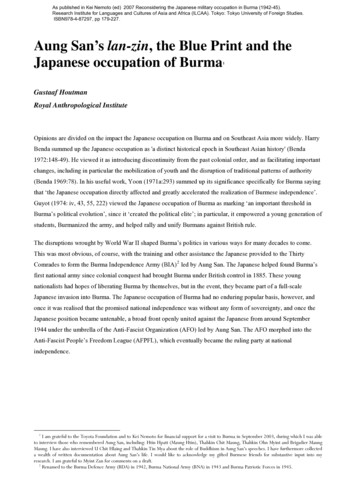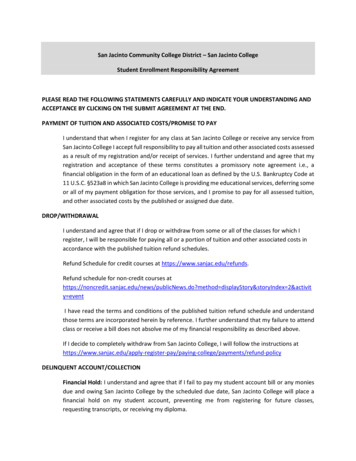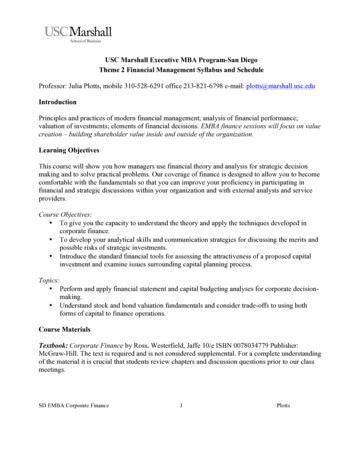
Transcription
As published in Kei Nemoto (ed) 2007 Reconsidering the Japanese military occupation in Burma (1942-45).Research Institute for Languages and Cultures of Asia and Africa (ILCAA). Tokyo: Tokyo University of Foreign Studies.ISBN978-4-87297, pp 179-227.Aung San’s lan-zin, the Blue Print and theJapanese occupation of Burma1Gustaaf HoutmanRoyal Anthropological InstituteOpinions are divided on the impact the Japanese occupation on Burma and on Southeast Asia more widely. HarryBenda summed up the Japanese occupation as 'a distinct historical epoch in Southeast Asian history' (Benda1972:148-49). He viewed it as introducing discontinuity from the past colonial order, and as facilitating importantchanges, including in particular the mobilization of youth and the disruption of traditional patterns of authority(Benda 1969:78). In his useful work, Yoon (1971a:293) summed up its significance specifically for Burma sayingthat ‘the Japanese occupation directly affected and greatly accelerated the realization of Burmese independence’.Guyot (1974: iv, 43, 55, 222) viewed the Japanese occupation of Burma as marking ‘an important threshold inBurma’s political evolution’, since it ‘created the political elite’; in particular, it empowered a young generation ofstudents, Burmanized the army, and helped rally and unify Burmans against British rule.The disruptions wrought by World War II shaped Burma’s politics in various ways for many decades to come.This was most obvious, of course, with the training and other assistance the Japanese provided to the ThirtyComrades to form the Burma Independence Army (BIA) 2 led by Aung San. The Japanese helped found Burma’sfirst national army since colonial conquest had brought Burma under British control in 1885. These youngnationalists had hopes of liberating Burma by themselves, but in the event, they became part of a full-scaleJapanese invasion into Burma. The Japanese occupation of Burma had no enduring popular basis, however, andonce it was realised that the promised national independence was without any form of sovereignty, and once theJapanese position became untenable, a broad front openly united against the Japanese from around September1944 under the umbrella of the Anti-Fascist Organization (AFO) led by Aung San. The AFO morphed into theAnti-Fascist People’s Freedom League (AFPFL), which eventually became the ruling party at nationalindependence.1I am grateful to the Toyota Foundation and to Kei Nemoto for financial support for a visit to Burma in September 2003, during which I was ableto interview those who remembered Aung San, including: Htin Hpatt (Maung Htin), Thahkin Chit Maung, Thahkin Ohn Myint and Brigadier MaungMaung. I have also interviewed U Chit Hlaing and Thahkin Tin Mya about the role of Buddhism in Aung San’s speeches. I have furthermore collecteda wealth of written documentation about Aung San’s life. I would like to acknowledge my gifted Burmese friends for substantive input into myresearch. I am grateful to Myint Zan for comments on a draft.2Renamed to the Burma Defence Army (BDA) in 1942, Burma National Army (BNA) in 1943 and Burma Patriotic Forces in 1945.
As published in Kei Nemoto (ed) 2007 Reconsidering the Japanese military occupation in Burma (1942-45).Research Institute for Languages and Cultures of Asia and Africa (ILCAA). Tokyo: Tokyo University of Foreign Studies.ISBN978-4-87297, pp 179-227.Plagued by splits, the AFPFL was in power for almost fifteen years until the military took over in 1962. 3The Japanese occupation ceased once the Japanese army left but, as I argue here, the consequences continue. TheJapanese occupation of Burma, though perhaps not always explicitly seen as such, precipitated a structuredpolitical unity in opposition, initially to fascism (eventhough some Burmese earlier welcomed the Japanese asliberators from British colonialists). Having had the benefit of military, administrative and organizationalexperience in government, subsequent opposition against the Japanese also provided the necessary politicalstructure to oppose the British once they returned, as is clear from the history of the AFPFL at the time (indeed,Aung San judged Japanese and British forms of colonialism as both ‘fascist’).The consequences of the Japanese occupation for Burma even survived Ne Win’s 1962 coup and thedisintegration of the AFPFL. Here I contend that the Japanese military involvement with Burma lives forthpolitically and academically in the form of an artificially constructed legacy surrounding Aung San dating back tothe preparations for the Japanese occupation.Dr Maung Maung (1949, 1962a, 1962b, 1969c, 1969d) documented Aung San’s life and communications indetail. He had privileged access to sources at the Defence Services Historical Research Institute, founded in 1955to house correspondence and papers related to the army that Aung San had founded. Himself a biographer ofAung San, Dr Maung Maung (1969a, 1969b) volunteered as a soldier in the Burma Independence Army at the endof 1942. He became Ne Win’s official biographer and eventually briefly formal successor as President of Burma.Dr Maung Maung was ‘selected’ to become BSPP Chair by the Central Committee of BSPP on 19 August 1988and as President by the Pyithu Hluttaw on 20 August 1988.Silverstein (1973:3) noted that ‘although Burma and its modern history have commanded the attention of bothBurmese and foreign scholars’ he found that ‘only one, Dr Maung Maung, has attempted to discover, interpret,and relate the ideas of Aung San to the march of events in his nation during the initial two critical years followingthe end of the Second World War’. A prolific writer, in his numerous publications Dr Maung Maung portrayedAung San as a martyr for the county, but he portrayed Ne Win as Aung San’s inheritor. Below I show how DrMaung Maung conjured up an impression of Aung San as a decisive authoritarian figure of a particular kind. DrMaung Maung shored up his image of Aung San ostensibly on the Blue Print, a communication dating frombefore the Japanese occupation of Burma that he attributed to Aung San. Aung San’s authorship is very much indoubt. Also, unlike other plans by the Japanese military and by Burmese nationalists, this document did not playan historical role of any particular importance. Nevertheless, this did not prevent Dr Maung Maung from using itto help legitimate one-party rule after 1962. Many scholars have accepted Dr Maung Maung’s attribution of thisdocument to Aung San without3AFPFL split in June 1958 and Ne Win’s ‘care taker’ government ruled the country from 27 October 1958 to 4 April 1960. The elections held on6 February 1960 and 29 February 1960 were won by U Nu’s ‘Union Party’ and at least formally was no longer be the ‘original’ AFPFL which tookover in times of Burma’s independence in January 1948.- 180 -
As published in Kei Nemoto (ed) 2007 Reconsidering the Japanese military occupation in Burma (1942-45).Research Institute for Languages and Cultures of Asia and Africa (ILCAA). Tokyo: Tokyo University of Foreign Studies.ISBN978-4-87297, pp 179-227.question, and have come to rely on Dr Maung Maung as a useful source. This legacy therefore needs explicitdeconstructing.To raise questions about this document is also to raise questions about a document implicated in the legitimationof Burma’s military political history. The Burmese army was born in Japan, and justification of army rule hithertohas necessarily involved rooting out what Aung San’s ideals were purported to have been at the time of its birth.The Blue Print is one of very few such documents. It is ironical, however, that this document refers less to thespirit of Aung San’s ideas, than to writings dictated by ‘foreign’ Japanese soldiers with strategic military interestsin Burma at the time. The error of locating Burman national ideology in a fascist document goes some way toexplain the state that Burma is in today. Furthermore, since Aung San Suu Kyi has repeatedly expressed herpolitics as having continuity with Aung San’s as a struggle for freedom conjoint with national independence, thisquestion is of more than passing interest even today.Aung San’s lan-zin and the Blue PrintCharacterised in Burma as the ‘father of the union of Burma’ and as the ‘great architect of national independence’Aung San continues to be immensely popular. His communications continue to have political influence in Burma,even today. Seeking to appropriate his reputation, the military junta and aspiring politicians have routinelytargeted Aung San’s communications.In his introduction to a volume of biographical sketches of Aung San, Dr Maung Maung (1962a:viii) asserts thatAung San had his own distinct ‘way’ or ‘roadmap’ (lan-zin) that was to remain relevant to the nation long after hisdeath:The name Aung San does not merely bring back tender memories in Burma, it awakens the political conscience as well. People remember whathe stood for: honesty and hard work, unity and discipline, and such homely virtues they talk of these as the ‘Aung San way’ or his lanzin [path],the way they must, or should try to go. Politicians always claim that they are the faithful followers of the lanzin.Dr Maung Maung here interprets Aung San’s lanzin as essential political capital abused by the early inheritors ofBurma’s national independence:Early in 1958, when the party which Aung San led as a united front broke into two factions, both proclaimed themselves to be such followersand promptly marched off in opposite directions. The Aung San Park in Rangoon is where the children come to play, and the politicians topledge. Aung San’s pictures on the ballot boxes doubtless won the then-undivided party many seats in the parliamentary elections of 1951-52,and 1956, and it was only in 1958, when the two contending factions could not agree on which of them should enjoy the exclusive use of thevote-winning picture that an election rule was added disallowing candidates and parties the use of it.Dr Maung Maung presents Ne Win’s Caretaker Government in 1958 as having brought order to what was by thena divided AFPFL, in which two factions bickered over Aung San’s legacy. He also describes how Ne Win put anend to anyone claiming Aung San’s legacy, namely by forbidding use of Aung San’s portrait in politicalcampaigns. The Ne- 181 -
As published in Kei Nemoto (ed) 2007 Reconsidering the Japanese military occupation in Burma (1942-45).Research Institute for Languages and Cultures of Asia and Africa (ILCAA). Tokyo: Tokyo University of Foreign Studies.ISBN978-4-87297, pp 179-227.Win regime thereby constrained use of Aung San’s image by anyone but itself. This attempt to monopolize theAung San image fell apart in 1989, once Aung San Suu Kyi claimed his heritage as his daughter, leaving hisheritage as a dangerous legacy outside of military control. 4One reason why Ne Win did not permit any political factions to claim Aung San was that he had decided to claimAung San for himself. In fact, by the time of the 1962 coup, Ne Win had himself completely appropriated AungSan’s legacy (lanzin) for the Burma Socialist Programme Party (BSPP), also known as the Myanma SoshelitLanzin Pati, or more simply, Lanzin Party, when ‘the Socialist way’ (Soshelit Lanzin) was proclaimed as that ofAung San’s. 5In his two biographies of Ne Win, published seven years after he published his research on Aung San, Dr MaungMaung (1969a:294-300, 1969b:427-431) marries the lanzin of the Burma Socialist Programme Party under NeWin to his construction of the lanzin of Aung San. Despite Aung San’s clear-stated post-war preferences fordemocracy as necessarily preceding socialism, 6 Dr Maung Maung condemns democracy as unworkable andselectively dated Aung San’s vision of politics back to the Blue Print, a document that supported Dr MaungMaung’s ideal of one-party rule.Why did Dr Maung Maung feel the need to validate BSPP ideology in terms of a document composed just asBurma was about to come under the sphere of influence of Japan? Dr Maung Maung (1925-1994), was one of theearliest academics to research Aung San’s life, and, apart from authoring an early biography, he also edited AungSan’s earliest academic portraits and bibliographies. However, Dr Maung Maung was by no means a ‘mere’academic alone. Despite his considerable academic qualifications (with a doctoral degree from Utrecht andacademic research at, and a further doctorate from Yale University), Dr Maung Maung was first AssistantAttorney-General in the Ne Win caretaker government between 1958 and 1960. After the 1962 military coup, NeWin appointed him first as a Judge of the Chief Court on 11 July 1962 and in early June 1965 as Chief Judge(later they changed its nomenclature to ‘Chief Justice’). From 1971, he also became a member of the centralcommittee of the Burma Socialist Programme Party. He was one of the main drafters of the 1974 constitution anddesigned important changes to the judicial system. Apart from having been Ne Win’s sanctioned biographer, hebriefly acted as Ne Win’s successor as President of Burma during the turbulent end of the BSPP period betweenAugust and September 1988.Dr Maung Maung developed a strong personal political loyalty to Gen Ne Win, in terms of which he interpretedAung San’s legacy. Virtually all academics concerned with Burma, and these includes contemporaries and evenrelatives of Aung San, cites and4Aung Pe was arrested on 14 February 2005 and sentenced to three years in prison by Twante Township court for saluting the portrait of Burma’snational hero and father of NLD leader Aung Suu Kyi, Gen Aung San, and singing a song honouring him, with his pupils. ‘Burmese tuition teachergets three years for saluting national hero.’ Democratic Voice of Burma News, 26.08.05; ‘Burmese private tuition teacher Aung Pe’s appeal rejected’.Democratic Voice of Burma News, 26.10.05.5On the use Ne Win made of Aung San see 8-1046Aung San's address at the AFPFL Convention, Jubile
Dr Maung Maung condemns democracy as unworkable and selectively dated Aung San’s vision of politics back to the Blue Print, a document that supported Dr Maung Maung’s ideal of one-party rule. Why did Dr Maung Maung feel the need to validate BSPP ideology in terms of a document composed just as . 4











